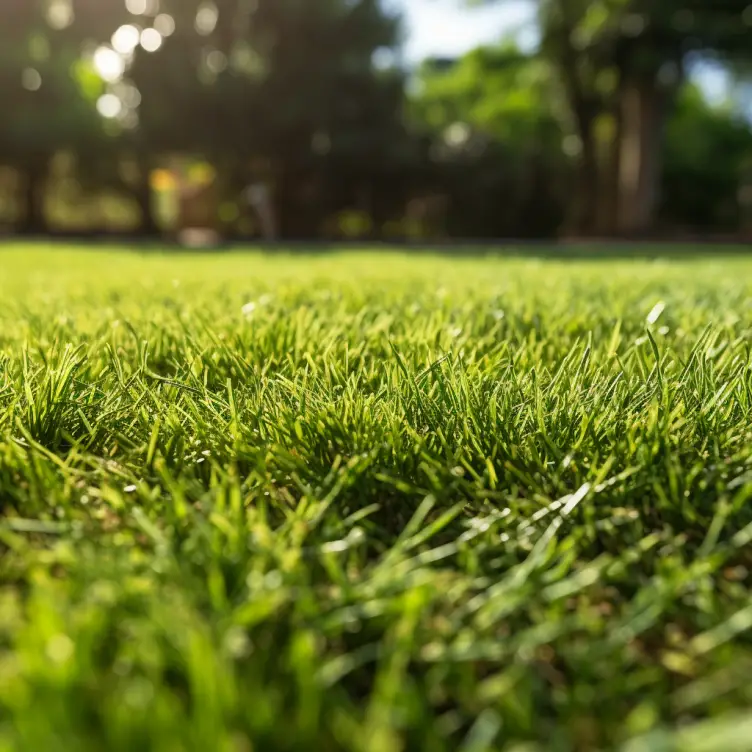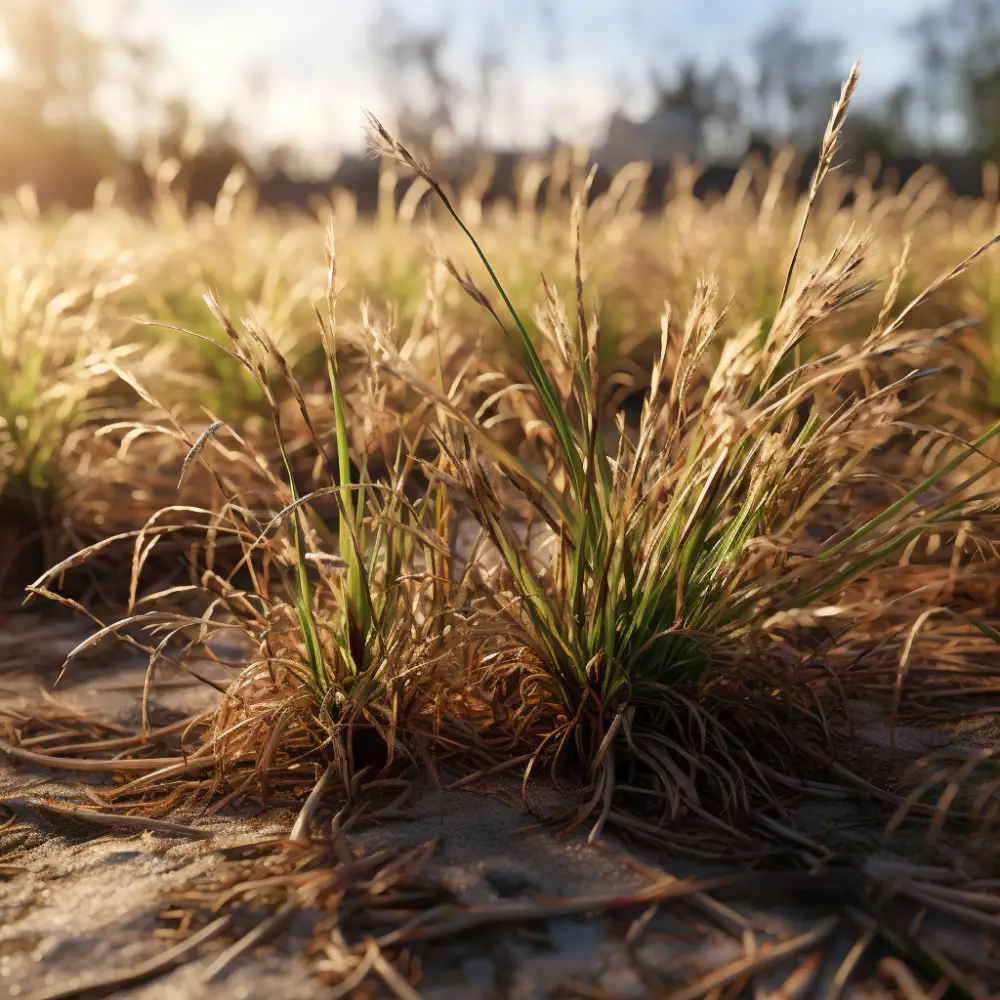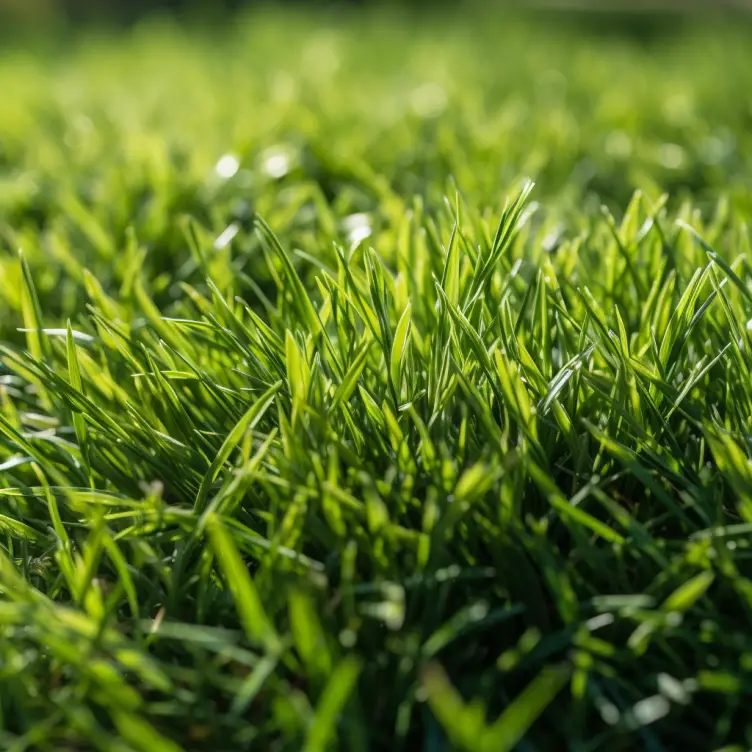Have you headed south on a trip and admired the bermuda grass lawns in warm weather states like Texas and Florida? Have you wondered if you can grow bermuda grass in a colder weather states like Ohio?
Growing bermuda grass in the mid-west can be challenging due to the length of time it stays dormant in colder weather. Dormant bermuda takes on a brown and withered look – it looks like it’s dead, which is unappealing to most homeowners
That’s not to say it can’t be done, but you should know what what’s ahead before you make a decision to lay a bermuda grass lawn in the mid-west. Let’s dive into the details to make a determination if bermuda grass is right for you.
- Can You Grow Bermuda Grass in the Midwest?
- Why Bermuda Grass Likes The Weather it Does
- Bermuda Grass Growth Pattern and Cold Weather
- How Quickly Does Bermuda Grass Go Dormant?
- Length of Winter vs. Temperature Level
- Dormant Bermuda Grass vs. Growing Bermuda Grass
- How to Grow Bermuda Grass in the Midwest
- Conclusion
Can You Grow Bermuda Grass in the Midwest?
Wondering if you can grow bermuda grass in Ohio? If you thought Bermuda grass was only for warm, southern climates, think again! With the right knowledge and techniques, you can successfully grow Bermuda grass in colder regions like Ohio.
That being said, I’ll be totally honest with you, growing bermuda grass in Ohio is going to be a challenge. Bermuda grass is a warm season grass. It loves the sun and heat. That’s why you see it more in southern states than in the north. Unless you are just totally in love with bermuda and need to have it, you should probably look to a lawn variety that has higher cold tolerance.
Bermuda grass can be grown in the midwest but special steps need to be taken, including proper cultivar selection, to ensure that it won’t go dormant for a significant portion of the year.
In this comprehensive guide, we’ll delve into the secrets of cultivating and maintaining a beautiful Bermuda grass lawn that can withstand the challenges of cooler temperatures. Whether you have an open yard or shaded areas, we’ve got you covered with step-by-step instructions and expert tip.

Why Bermuda Grass Likes The Weather it Does
In order to understand how to make bermuda grass grow in colder climates, it’s helpful to understand why it likes warmer climates.
Bermudagrass (Cynodon dactylon) is native to warm and tropical regions, and its preference for warm weather is deeply rooted in its evolutionary adaptation to such climates. Here are some statistics and interesting facts that explain why bermudagrass thrives in warm weather:
- Optimal Growing Temperature: Bermudagrass grows best when the soil temperature is between 75°F and 85°F (24°C – 29°C). At these temperatures, its growth rate accelerates, and it can efficiently photosynthesize and convert sunlight into energy.
- Warm-Season Grass: Bermudagrass is classified as a warm-season grass, which means it actively grows during the warm months of the year and goes dormant during cooler temperatures. Its growth significantly slows down when temperatures drop below 60°F (15°C).
- Winter Dormancy: During the winter months in colder climates, bermudagrass turns brown and goes dormant to conserve energy. It does this as a survival strategy to withstand freezing temperatures, frost, and other harsh winter conditions.
- Rhizomatous Growth: Bermudagrass has an extensive and aggressive rhizomatous growth habit, meaning it has an ability to spread and establish new shoots horizontally through underground stems called rhizomes. This growth pattern allows it to spread quickly and form a dense turf. It also helps it compete with other grasses and weeds in warm conditions.
- Drought Tolerance: Bermudagrass has excellent drought tolerance, enabling it to survive and thrive in regions with hot and dry summers. It can withstand extended periods of heat and limited water availability.
- Resilience to Foot Traffic: One of the reasons bermudagrass is popular for sports fields and high-traffic areas is its ability to recover quickly from damage. It can repair itself rapidly, thanks to its vigorous growth and regenerative capabilities.
- Nutrient Requirements: Bermudagrass has relatively low nutrient requirements, making it well-suited for the typically infertile soils found in warm climates. It can efficiently extract essential nutrients from the soil.
In summary, bermudagrass evolved in warm climates, and its growth patterns, resilience, and nutrient requirements are all optimized for thriving in these conditions. While it can survive in colder climates, it performs best and exhibits its full potential in regions with consistently warm weather.
Bermuda Grass Growth Pattern and Cold Weather
Bermuda grass has a remarkable ability to withstand cold weather due to its unique root structure. It also contributes to its hardiness and is why it’s hard to get rid of. Ask any homeowner trying to maintain a fescue lawn who has a next-door neighbor with a bermuda grass lawn.
During the winter months, as temperatures drop, Bermuda grass enters a period of dormancy. As it prepares for the colder season, the plant starts allocating its energy and nutrients to its root system. The roots of Bermuda grass, especially the rhizomes and stolons, play a crucial role in its cold tolerance.
Rhizomes are horizontal underground stems that store carbohydrates and energy, allowing Bermuda grass to survive and remain viable even when the above-ground portions of the plant go dormant. These rhizomes are well-insulated beneath the soil, and run deep. Deeper than most grasses.
These rhizomes protect the lawn from freezing temperatures. Additionally, they have the ability to store starches, which serve as reserves to fuel regrowth when warmer conditions return.
Stolons, on the other hand, are above-ground stems that also aid in cold resistance. They help the Bermuda grass spread and create new growth points. During the cold season, stolons can retract into the soil, further protecting the plant from freezing temperatures.
By prioritizing root growth and storing energy in rhizomes and stolons, Bermuda grass can survive the winter, even in colder climates. Once spring arrives and temperatures rise, the stored nutrients and energy in the root system fuel rapid regrowth, enabling Bermuda grass to green up and thrive again. This remarkable adaptability to cold weather makes Bermuda grass a popular choice in warm-season grasses for many regions with mild winters.
How Quickly Does Bermuda Grass Go Dormant?
Bermuda grass typically starts to go dormant after experiencing several consecutive days of temperatures consistently below 60 degrees Fahrenheit. The exact timing can vary depending on the specific cultivar, local climate, and other environmental factors.
In cooler regions, such as Ohio and other northern states, bermuda grass may begin to show signs of dormancy as early as late fall when temperatures drop consistently below 60°F. During this period, the grass growth slows down, and the green color starts to fade.
As temperatures continue to drop, bermuda grass eventually enters full dormancy, appearing brown and inactive until warmer temperatures return in the spring.
Length of Winter vs. Temperature Level
Now that you know a bit more about how bermuda grass survives, you’re on your way to understanding why it likes warm season climates and why you don’t see it colder climate areas as much.
It’s not how cold it gets. Like I mentioned, it can survive cold winters and freezing temperatures. Those deep roots insulate itself from extreme cold. It will survive an Ohio winter no problem.
The length of winter is more of a factor. Specifically, what length of time does the area experience temperatures that drop below 60°F? Some southern states only experience a few months of temperatures dropping below 60°F. As you travel north, that length of time increases.
Here’s a sample of states with the average length of time in Months that they experience temperatures of 60°F or less:
| State | Average months of sub-60°F Temperatures |
|---|---|
| Maine | 6.8 |
| Ohio | 5.7 |
| Oklahoma | 3.6 |
| Georgia | 1.2 |
| Florida | 0 |
This means that when you grow bermuda grass in Ohio, it’s going to be dormant for about 6 months, whereas in Florida there’s a good chance it won’t go dormant at all.
Dormant Bermuda Grass vs. Growing Bermuda Grass
As you might guess, dormant bermuda grass doesn’t look great. In fact to an untrained eye dormant bermuda grass looks dead. It’s not something you’re going to be proud showing off to dinner guests and family reunions at your home.
And that’s the main reason why most people don’t choose bermuda grass in Ohio. It will basically look like a dead lawn for nearly half the year.


How to Grow Bermuda Grass in the Midwest
If you’ve made it this far and are still determined to have a bermuda grass lawn in Ohio, heres what you can do to give yourself the best chance of keeping it out of dormancy for the greatest length of time
Choose the Right Variety of Bermuda Grass
Start your bermuda grass journey by selecting the most suitable variety for colder climates. Look for cold-tolerant cultivars that have proven their ability to thrive in less forgiving conditions. These varieties have been bred to withstand lower temperatures and are your best bet for success in Ohio.
- Laprima XD: This variety is specifically bred to withstand colder temperatures, making it an excellent choice for Ohio and other colder climates.
- Riviera: Riviera Bermuda grass is known for its cold hardiness and can maintain good color even during the winter months.
- Yukon: Yukon Bermuda grass is another cold-tolerant cultivar that can thrive in cooler regions and still provide a beautiful, dense lawn.
- Latitude 36: While not as cold-tolerant as some others on the list, Latitude 36 Bermuda grass still offers better winter hardiness compared to traditional Bermuda grass varieties.
When to Begin
Bermuda grass should be sown when the soil temperature consistently reaches around 65 to 70 degrees Fahrenheit (18 to 21 degrees Celsius) or higher. This usually occurs during late spring to early summer when the weather is consistently warm. Perhaps a little later in the Midwest.
Sowing the seeds when the soil is warm ensures optimal germination and establishment of the grass.
Soil Preparation and Seeding
Proper soil preparation is vital for successful Bermuda grass growth. Begin by mowing your existing lawn as low as possible to eliminate competition. Lightly till the soil to aerate it and create a conducive environment for the Bermuda grass seeds. Remove any debris, rocks, or weeds from the area.
Mix in a good pre-emergent fertilizer for your bermuda grass. You can find an entire article about bermuda grass fertilizer here.
Sowing Bermuda Grass
Choose high-quality bermuda grass seeds suitable for cooler climates. Coated seeds are preferred for better germination rates. Divide your lawn into manageable sections and evenly spread the seeds using a broadcast spreader. Aim for about 1-2 pounds of seed per 1,000 square feet. Lightly rake the soil to ensure the seeds are in contact with the soil.
Germination and Watering
Bermuda grass seeds need consistent moisture to germinate effectively. Water the newly seeded lawn lightly but frequently, ensuring the soil remains consistently moist until germination occurs, which typically takes 7-10 days. This usually means a light watering once or twice a day depending on hot it is.
Once germinated, reduce watering frequency but increase the amount of water applied during each session to encourage deep root growth.
Mowing Techniques
After your Bermuda grass reaches a height of around 2-3 inches, it’s time for the first mowing. Set your mower to a low height and cut the grass to approximately 1 inch. Regular mowing is crucial to stimulate lateral growth and increase lawn density. During the active growing season, mow every 5-7 days, never removing more than one-third of the grass height at a time.
Fertilization and Maintenance
To keep your Bermuda grass lawn healthy and vibrant, fertilize it with a high-nitrogen fertilizer during its peak growing season, usually in late spring and early summer. Follow the manufacturer’s instructions carefully to avoid over-fertilization. Regularly inspect your lawn for pests and diseases, addressing any issues promptly to maintain its lush appearance.
Conclusion
With the right approach and variety selection, growing Bermuda grass in Ohio’s colder climate is not only possible but rewarding. Remember to choose cold-tolerant varieties, prepare the soil thoroughly, and follow the proper seeding and maintenance techniques.
Your Bermuda grass lawn will not only survive but thrive, giving you a picturesque and resilient outdoor space to enjoy throughout the seasons. So, gear up and get ready to embrace the beauty of Bermuda grass in your Ohio lawn!

